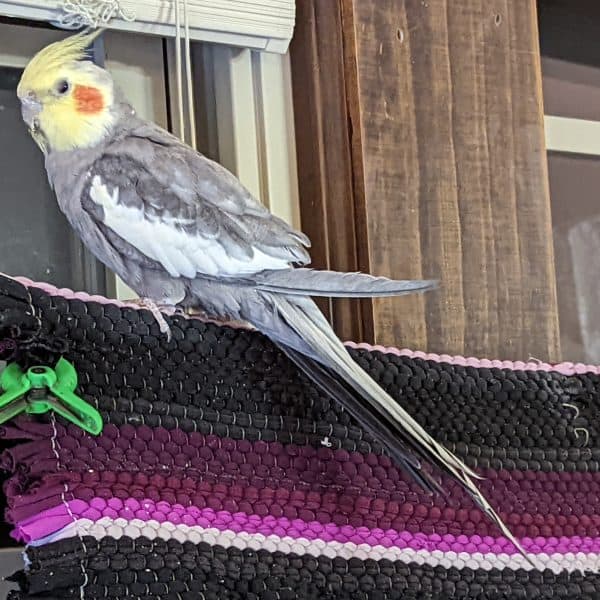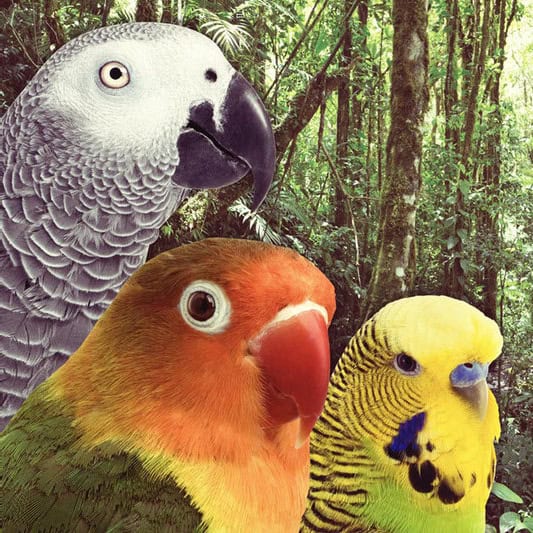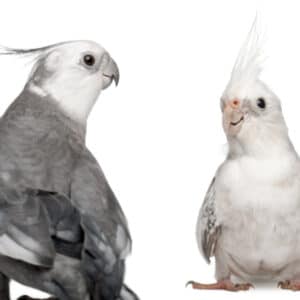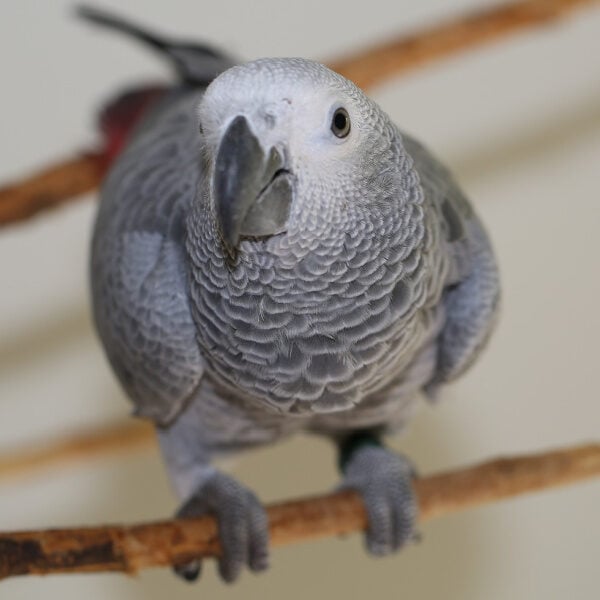Last Updated on by Mitch Rezman
Greetings to all you fellow crazy bird people,
Ever wonder about the guy that looked at a silkworm and said “That would make a great shirt!”
At 71 I wonder more than ever, kind of trying to keep up with all things digital, and science it’s all so breathtaking and fast-moving.
I’m tired of listening to all the child billionaires whining about god knows what and then buying half a country.
That’s why we immerse ourselves in birds, right?
As noisy as they are…
…they bring a richness not found with fins and fur.
They fly.
So I take solace in the chortle of the bugger’s ‘er budgies listening to them plan their day in the morning and busy themselves until I stumble to the staircase where Catherine left the food tray with clean water dishes, and 3 veggie mash-ups for them and Barney our tiel.
I will have by then, brought down the big brothers, Keto (African ringneck) and Chili (Quaker in the video above) where their fresh veggies await them in their day cages.
While Barney stares me down at my desk from the headboard (I have a short work commute),

I’ll ask myself, “Why are your cute cheeks so orange dude?”
Feathered factoid: when you can determine the sex of the bird by its color (we talk about Eclectus parrots below) it is called sexual dimorphism.
Sexual dimorphism occurs in about 20% of bird species.
We know Keto our African ringneck is a male because of his ring which females lack such a necklace.
Here’s my research.
Cockatiels have orange cheeks
because of the presence of a pigment called psittacofulvin. Psittacofulvin is a carotenoid pigment, which is a type of pigment that is found in plants and animals. It is responsible for the yellow and orange coloration in many birds, including cockatiels.
The amount of psittacofulvin in a cockatiel’s feathers is determined by its genetics. Male cockatiels typically have more psittacofulvin than female cockatiels, which is why their cheeks are more orange.
The orange cheeks of cockatiels are thought to be a form of sexual dimorphism, which is a difference in appearance between males and females of the same species. Sexual dimorphism is often used by animals to attract mates. In the case of cockatiels, the orange cheeks of males may help them to attract females.
In addition to being a form of sexual dimorphism, the orange cheeks of cockatiels may also serve as a way for them to communicate with each other. The color of a cockatiel’s cheeks can change depending on its mood. For example, a cockatiel that is feeling angry or agitated may have brighter orange cheeks than a cockatiel that is feeling relaxed or content.
The orange cheeks of cockatiels are a beautiful and unique feature that helps to make these birds so popular as pets.
African Greys have red tails
for a variety of reasons. Some of these reasons include:
- To attract mates. The brighter the red tail, the more attractive the parrot is to potential mates.
- To communicate with other African Greys. The color of the tail can be used to communicate a variety of things, such as mood, location, and danger.
- To deter predators. Many predators associate the color red with danger, so flashing their tails can help to scare off predators.
- To help them fly. The red tail feathers are larger and more aerodynamic than the other feathers, which helps African Greys to fly more efficiently.
It is likely that the red tail of the African Grey is a combination of all of these factors. The bright red color helps the parrot to attract mates, communicate with other parrots, deter predators, and fly more efficiently.
Here are some additional details about each of these reasons:
- Attracting mates. The color of a bird’s feathers is often used to attract mates. In the case of African Greys, the brighter the red tail, the more attractive the parrot is to potential mates. This is because the color red is associated with health and vitality.
- Communicating with other African Greys. The color of the tail can also be used to communicate with other African Greys. For example, a parrot that is feeling threatened may flash its tail feathers to warn other parrots of danger. The color of the tail can also be used to communicate location. For example, a parrot that is lost may flash its tail feathers to signal to other parrots that it is looking for its flock.
- Deterring predators. Many predators associate the color red with danger. This is because some poisonous or venomous animals are red in color. So, when a predator sees a red bird, it may be less likely to attack.
- Helping them fly. The red tail feathers are larger and more aerodynamic than the other feathers. This helps African Greys to fly more efficiently. The red tail feathers also help to keep the parrot’s balance while it is flying.
Overall, the red tail of the African Grey is a beautiful and unique feature that helps the parrot to survive and thrive in the wild.
Male Eclectus parrots are green and females are red
because of sexual dimorphism, which is a difference in appearance between the sexes of the same species. Sexual dimorphism is often used by animals to attract mates. In the case of Eclectus parrots, the bright colors of the male and female help them to stand out from each other and from other birds.
The green coloration of the male Eclectus parrot helps him to blend in with the forest canopy, where he spends most of his time foraging for food. The red coloration of the female Eclectus parrot helps her to attract attention from males. The bright red color is also a signal to other females that she is already taken.
Sexual dimorphism is a common phenomenon in the animal kingdom. It is thought to have evolved as a way for animals to compete for mates and to ensure the survival of their genes. In the case of Eclectus parrots, the bright colors of the male and female help them to attract mates and to raise healthy young.
Here are some additional details about the sexual dimorphism of Eclectus parrots:
- Males are green: The green coloration of the male Eclectus parrot is due to the presence of a pigment called biliverdin. Biliverdin is a byproduct of the breakdown of red blood cells. The male Eclectus parrot has a higher concentration of biliverdin in his feathers than the female.
- Females are red: The red coloration of the female Eclectus parrot is due to the presence of a pigment called carotenoids. Carotenoids are pigments that are found in plants and animals. They are responsible for the yellow, orange, and red coloration in many birds, including Eclectus parrots. The female Eclectus parrot has a higher concentration of carotenoids in her feathers than the male.
- The difference in coloration is thought to be a form of sexual selection. Sexual selection is a process by which animals evolve traits that help them to attract mates. In the case of Eclectus parrots, the bright colors of the male and female help them to stand out from each other and from other birds. This makes them more likely to be noticed by potential mates.
- The bright colors of the male and female also help them to communicate with each other. The male Eclectus parrot uses his green coloration to blend in with the forest canopy, where he spends most of his time foraging for food. The female Eclectus parrot uses her red coloration to attract attention from males. The bright red color is also a signal to other females that she is already taken.
Overall, the sexual dimorphism of Eclectus parrots is a beautiful and unique feature that helps these birds to survive and thrive in the wild.
I fact-checked with NASA when learning about the colors of budgie feathers.
Light Up Your Bird Cage with Florescent Budgies a Gift from NASA
Best
MitchR
Author Profile
Latest entries
 The Traveling BirdJune 26, 2025Can You Name 5 Parrot Species That Are Living Wild in the USA?
The Traveling BirdJune 26, 2025Can You Name 5 Parrot Species That Are Living Wild in the USA? Bird BehaviorJune 26, 2025How is it Parrots Are Problem Solvers Social Animals and Even Use Tools?
Bird BehaviorJune 26, 2025How is it Parrots Are Problem Solvers Social Animals and Even Use Tools? Bird & Parrot AnatomyJune 25, 2025How a Tiny Chemical Modification Makes Parrots Nature’s Living Paintings
Bird & Parrot AnatomyJune 25, 2025How a Tiny Chemical Modification Makes Parrots Nature’s Living Paintings PigeonsJune 20, 2025How Do Parrots Thrive in Cities Outside Their Native Habitats?
PigeonsJune 20, 2025How Do Parrots Thrive in Cities Outside Their Native Habitats?




